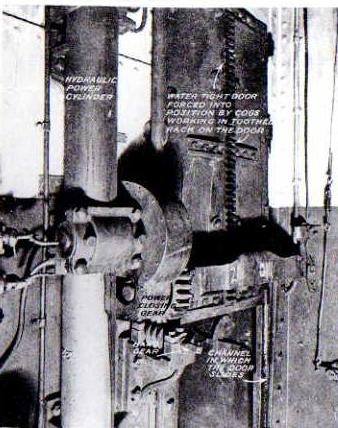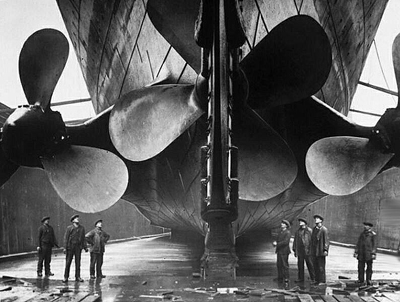|
Go to Belfast
Shipyard home page.
|
The Titanic.
Built by Harland & Wolff of Belfast. |

|
Building
& Machinery. |
||
|
At the time of Titanic's construction
Harland & Wolff was generally regarded as the most technically advanced
shipyard in the world. Most of their competitors had the capacity to Titanic was an Olympic class passenger liner and was the second of three ordered by the White Star Line. When the orders for the ships was placed the shipyard did not have any slips large enough to accommodate the hulls which were to be 882 feet long and 92 ft wide. Three existing slips were combined and a gigantic gantry the largest of its kind ever built was constructed enabling two of the ships to be built at a time. The Olympic was the first her keel was laid on the 16th December 1908, she was launched on the 20th October 1910 and completed in May 1911, The Titanic's keel was laid on the 31st March 1909, framed by April 1910, frame plated by October 1910 and launched on 31 March 1911, the ships were fitted out at the quay side using a 200 ton floating crane. All three ships were plated with
one inch (25.4 mm) steel plate, the hulls had two safety featured in
their design, Olympic class liners had three engines with a combined power of 50,000 horse power, the port and starboard engines were reciprocating piston engines the exhausting steam from them led to a low pressure turbine driving the center propeller. This design was unique to Harland's and had been tried out on the Laurentic. Steam for the three engines, and to power generators etc was supplied by twenty nine boilers with 159 fireboxes. Alexander Carlisle managing director
of the shipyard until 1910, originally proposed that the Titanic should
carry 64 lifeboats, after his retirement this number was halved. This belief probably stem's from an incident which occurred on the 23 January 1909 when the Republic was involved in a collision off Nantucket when bound for New York, all the passenger's were rescued and the Republic sank 38 hours later. In fairness to the White Star Line there were no ships on the north Atlantic run with the capacity to rescue all their passengers and crew. Surely it was lax of the board of trade not to have lifesaving requirements when in the space of twenty years the size of ships engaged in the transatlantic grew in size by some four hundred percent. The image above shows the the propellers of the Olympic class liners, the wing propellers weigh 38 tons and are 23ft 6" (7.29M) diameter they have bronze blades with a cast steel boss, the wing shafts were 28.5” (724 mm) diameter The centre propeller weighs 28 tons and is 16ft 6" (5.03M) diameter it is cast from manganese-bronze, the centre shaft was 22.5" (571.5 mm) diameter |
||
Go
to Belfast Shipyard home page. |
|

 build and fit out the hulls, but Harland's could also make all the machinery,
including the engines, generators and winches etc, they also had large
foundry facilities in which all cast iron or bronze items required such
as portholes, valves and the like.
build and fit out the hulls, but Harland's could also make all the machinery,
including the engines, generators and winches etc, they also had large
foundry facilities in which all cast iron or bronze items required such
as portholes, valves and the like. there
was a double bottom with about six feet headroom, and secondly the hull
was divided into sixteen watertight compartments by fifteen half inch
(12 mm)steel bulkheads, the design would enable the ships to remain
afloat with any two compartments flooded, the worst scenario envisaged
was that the ship be struck amidships and holed flooding at the most
two compartments. Access between the compartments was by means of watertight
doors which could be operated from the bridge, a lever beside the door,
or an automatic trip in the event of flooding, these provisions led
people to believe Titanic to be unsinkable.
there
was a double bottom with about six feet headroom, and secondly the hull
was divided into sixteen watertight compartments by fifteen half inch
(12 mm)steel bulkheads, the design would enable the ships to remain
afloat with any two compartments flooded, the worst scenario envisaged
was that the ship be struck amidships and holed flooding at the most
two compartments. Access between the compartments was by means of watertight
doors which could be operated from the bridge, a lever beside the door,
or an automatic trip in the event of flooding, these provisions led
people to believe Titanic to be unsinkable. White Star vetoed this and elected to comply with board of Trade regulations
which stated that a vessel in excess of 10,000 tons should carry 16
lifeboats, remember the Titanic was four and a half times larger, to
have equipped Titanic with more boats would have cost a considerable
amount of money and would have left the rest of their fleet appearing
under equipped. It was the thinking at the time that a ship involved
in the north Atlantic passenger trade where there was considerable traffic,
would take hours if not days to sink and that the lifeboats would only
be needed to ferry passengers to waiting ships.
White Star vetoed this and elected to comply with board of Trade regulations
which stated that a vessel in excess of 10,000 tons should carry 16
lifeboats, remember the Titanic was four and a half times larger, to
have equipped Titanic with more boats would have cost a considerable
amount of money and would have left the rest of their fleet appearing
under equipped. It was the thinking at the time that a ship involved
in the north Atlantic passenger trade where there was considerable traffic,
would take hours if not days to sink and that the lifeboats would only
be needed to ferry passengers to waiting ships.